To maintain worker safety while performing de-energized and grounded line maintenance, two important factors must be accomplished in the event of a fault:
- The fault current must be cleared in the fastest available time
- The current across the line worker must be limited to a safe level by creating an Equi-Potential Zone (EPZ)
Addressing the Equi-Potential Zone
OSHA addresses the EPZ this way: “1910.269(n)(3) Equi-potential zone. Temporary protective grounds shall be placed at such locations and arranged in such a manner that the employer can demonstrate will prevent each employee from being exposed to hazardous differences in electric potential. Note to paragraph (n)(3): Appendix C to this section contains guidelines for establishing the Equi-potential zone required by this paragraph. The Occupational Safety and Health Administration will deem grounding practices meeting these guidelines as complying with paragraph (n)(3) of this section.”
In 2014, OSHA 1910.269 Appendix C was modified to include guidelines on how employers comply with 1910.269(n)(3). OSHA 1910.269 Appendix C Section III mentions that an employer is required to make an engineering determination to ensure that grounding practices do not expose employees to hazardous differences in electrical potential. Section III.D.2 provides additional detail on acceptable methods of grounding. OSHA 1910.269 Appendix C Section III.D.2, explains the acceptable methods of grounding for employers that do not perform an engineering determination. In this instance, employers are required to comply with the following:
- Maximize the fault current with a low impedance connection to ground to ensure the circuit opens in the fastest available clearing time (Refer to Section III.D.2.i)
2. Bond all conductive objects in the work area to minimize differences in potential
“Wood poles are conductive objects. The poles can absorb moisture and conduct electricity, particularly at distribution and transmission voltages. Consequently, the employer must either: (1) Provide a conductive platform, bonded to a grounding cable, on which the worker stands or (2) use cluster bars to bond wood poles to the grounding cable. The inner portion of the wood pole is more conductive than the outer shell, so it is important that the cluster bar be in conductive contact with a metal spike or nail that penetrates the wood to a depth greater than or equal to the depth the worker's climbing gaffs will penetrate the wood. For example, the employer could mount the cluster bar on a bare pole ground wire fastened to the pole with nails or staples that penetrate to the required depth. Alternatively, the employer may temporarily nail a conductive strap to the pole and connect the strap to the cluster bar.”
In the IEEE Study 80-1986, the effects of using a cluster bar to reduce the voltage and current across a line worker has been investigated. The study uses a three-phase WYE distribution system with the following parameters:
- 7,200-volt system
- 911 Ohm resistor for the worker
- 4,200-5,700 Amp fault current
When employees are not using the cluster bar, the current across the line worker measures 1.88 Amp (1,745V) which is above the 100mA harmful threshold. When seeing the same fault and adding the cluster bar, the current across the worker dropped to 21mA (19.5V). The cluster bar in this example would more than likely save the line worker’s life in the event of a fault current.
Proper Installation of Cluster Bars on Wooden Poles
While climbing a pole and creating the Equi-Potential Zone (EPZ), it is imperative to use a cluster bar that is installed in the correct location. Installation below the line worker’s feet ensures that the body of the worker is in the EPZ during de-energized and grounded line maintenance. This installation helps reduce the current flow through the body in the event of a fault current. As previously mentioned, it is recommended that the cluster bar be in conductive contact if it is being used on a wooden pole. CHANCE offers a variety of clusters bars with custom options if longer chains are needed for transmission towers or poles.
Working from an Insulated Bucket Truck
In addition to working on wooden poles, cluster bars are also ideal when working from an insulated bucket truck. If a line worker’s body makes contact with a portion of the pole or crossarm, the potential for hazardous current flowing through a worker’s body could occur if the items are not bonded. In this instance, it is recommended that a cluster bar be installed on the pole below the working area. A CHANCE bucket style Equi-Mat could also be used and bonded to the cluster bar ensuring the line worker’s hands and feet are close to Equi-Potential as possible.
Prioritizing Safety with Cluster Bars
Proper safety begins by using cluster bars during de-energized and grounded maintenance on wood poles, while working from an insulated bucket trucks and similar applications. CHANCE cluster bars comply with OSHA 1910.269(n)(3) and help reduce the current flowing through a line worker’s body in event of a fault. It is always recommended that employees continuously follow company safety practices and procedures.
Please comment below or reach out to your local Territory Manager if you have any questions regarding CHANCE Personal Protective Grounding Equipment.

